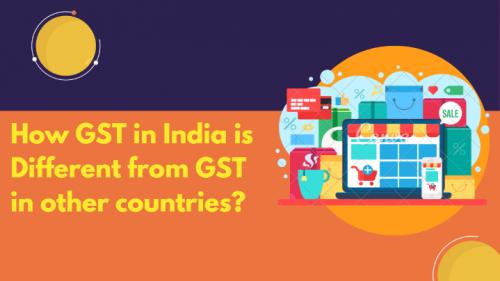How GST in India is Different from GST in other countries?

Goods and Services Tax (GST)
is a value-added tax system that has been implemented by various countries
around the world, including India. While the basic concept of GST remains
similar across nations, there are distinct differences between GST in India and
GST in other countries, particularly in terms of structure, rates, and implementation.
Firstly, the structure of
GST in India differs from other countries. India follows a dual GST model,
where both the central government and state governments levy and administer the
tax simultaneously. This means that there are two components of GST in India:
the Central GST (CGST) and the State GST (SGST). In contrast, some countries
have a single GST system administered solely by the central government.
Secondly, the GST rates in
India are relatively complex compared to other countries. In India, goods and
services are classified into different tax slabs, namely 0%, 5%, 12%, 18%, and
28%, with an additional cess on certain items. This multiplicity of rates aims to
accommodate the diverse nature of the Indian economy and its socio-economic
considerations. In contrast, some countries have a single standard rate of GST
applied uniformly across most goods and services.
Furthermore, the
implementation of GST in India has been unique in its scale and complexity. The
Indian GST regime incorporates a comprehensive online portal called the Goods
and Services Tax Network (GSTN) to facilitate registration, filing of returns,
and compliance. This technological infrastructure, including the GSTN, was
designed to manage the vast taxpayer base and the intricacies of India's
federal structure. Many other countries implementing GST do not have such an
extensive online platform.
Moreover, the Indian GST system has faced several challenges and has undergone numerous revisions since its introduction in 2017. The frequent changes in tax rates, compliance procedures, and exemptions have made it more dynamic and adaptive. In contrast, some countries had relatively stable GST systems from their inception, with fewer modifications over time.
It is also important to note
that the cultural and economic diversity of India adds another layer of
complexity to its GST system. The country's federal structure allows for
variations in tax rates and administration among different states, which can
result in challenges related to interstate trade and compliance. This level of
diversity is not as prevalent in some other countries with simpler and more
homogenous GST systems.
In conclusion, while the
basic principle of GST is similar across countries, the implementation and
specific features of GST in India distinguish it from other nations. The dual
structure, multiple tax rates, comprehensive online portal, dynamic nature, and
complexity arising from India's federal structure are some of the factors that
set Indian GST apart. These unique characteristics reflect the need to
accommodate the diverse nature of the Indian economy and society, making
India's GST system distinct in the global landscape of value-added tax regimes.
we provide the fastest company registration services with the highest approval rate and at an affordable cost.
Post Your Ad Here
Comments